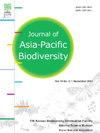印度尼科巴群岛海螺属一新种,1838(两栖纲:无尾目:海螺科)
IF 0.7
Q4 BIODIVERSITY CONSERVATION
引用次数: 0
摘要
众所周知,由于岛屿隔离,大尼科巴岛支持高度的疱疹动物多样性和地方性。利用形态学、声学和分子等方面的资料,对岛上的chalconota种群进行了分类地位和亲缘关系分析。基于16S rRNA的分子系统发育结果显示,该植物与chalconota复合体同系物的遗传差异较大,为9.19 ~ 16.45%。我们将该种群描述为一个新种,注意到其独特的形态特征和系统发育位置。本文章由计算机程序翻译,如有差异,请以英文原文为准。
A new species of Hylarana Tschudi, 1838 (Amphibia: Anura: Ranidae) from the Nicobar Islands, India
The island of Great Nicobar is known to support a high degree of herpetofaunal diversity and endemism due to insular isolation. Among them, the population of Hylarana chalconota on this island was assessed to determine its taxonomic status and affinities using morphological, acoustic, and molecular data. Molecular phylogeny based on 16S rRNA showed a considerable amount of genetic divergence with 9.19–16.45% from congeners of the Hylarana chalconota complex. We describe this population as a new species, noting its unique morphological characteristics and phylogenetic position.
求助全文
通过发布文献求助,成功后即可免费获取论文全文。
去求助
来源期刊

Journal of Asia-Pacific Biodiversity
Agricultural and Biological Sciences-Insect Science
CiteScore
1.70
自引率
12.50%
发文量
94
审稿时长
27 days
期刊介绍:
The Journal of Asia-Pacific Biodiversity (previous title was Journal of Korean Nature) is an official journal of National Science Museum of Korea (NSMK) and Korea National Arboretum (KNA). The scope of journal is wide and multidisciplinary that publishes original research papers, review articles, as well as conceptual, technical and methodological papers on all aspects of biological diversity-its description, analysis and conservation, and its application by humankind. This wide and multidisciplinary journal aims to provide both scientists and practitioners in conservation theory, policy and management with comprehensive and applicable information. However, papers should not be submitted that deal with microorganisms, except in invited paper. Articles that are focused on the social and economical aspects of biodiversity will be normally not accepted.
 求助内容:
求助内容: 应助结果提醒方式:
应助结果提醒方式:


